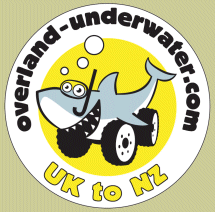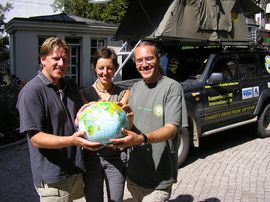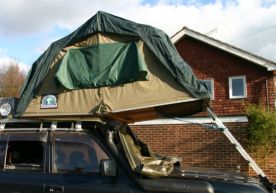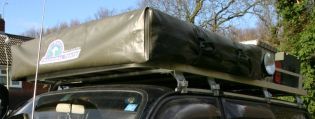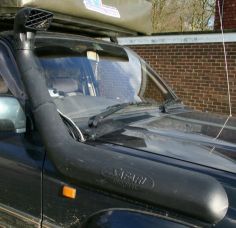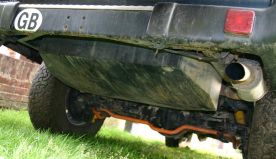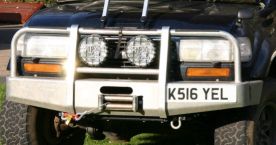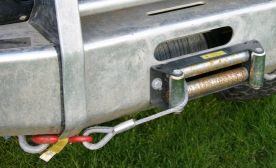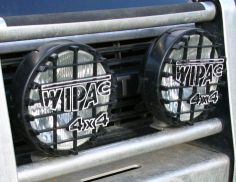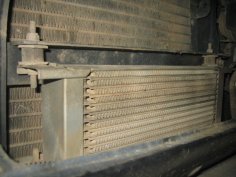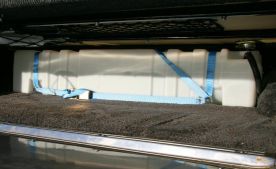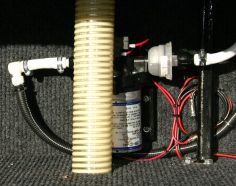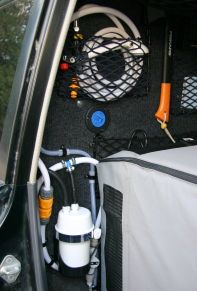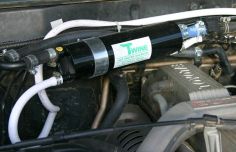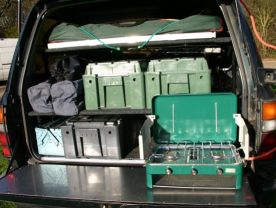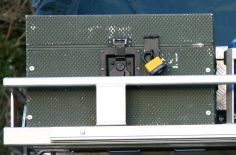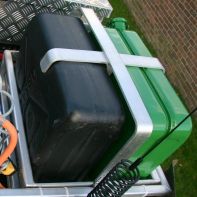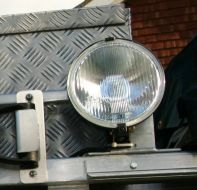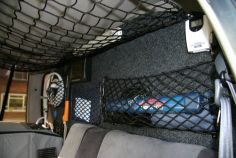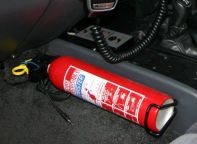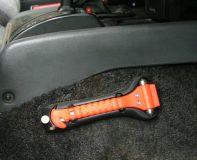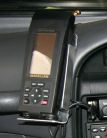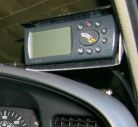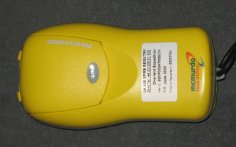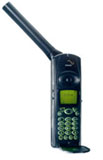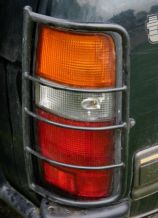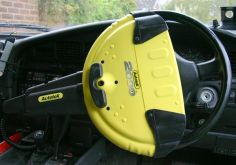| Final Statistics: Alex & Maz | Total distance: 93,550km |
| Furthest Point: Rotorua, NZ | Now settled in Sydney, Australia |
| Final Statistics: Martin | Total distance: 79,698km |
| Furthest Point: Hobart, Australia | Now settled in Bristol, UK |
Vehicle Preparation and Equipment
Vehicle Preparation and Equipment
|
|
|
|
Between the three vehicles, two cars used Frogs Island 4x4, whereas the third later decided on Footloose 4x4 after discussing the experiences of the first two. Reading between the lines I wouldn't say we were particularly satisfied with the quality of work undertaken by Frogs Island 4x4 and the prolonged amount of time it took meant we weren't able to progress with our own modifications. Although they were prepared to try and resolve most issues, this takes repeat visits to the workshop and further time. On the whole Footloose 4x4 stuck to their time estimate, thoroughly discussed the options available and advised where they thought expense un-necessary modifications were being requested. Apart from a few minor exceptions the work has been to a good standard and they've been very helpful when a problem was identified.
These are just our own experiences and there are many overland specialist preparation centres out there, so do your homework and choose wisely!
Many hours have been spent slowly converting the Land Cruisers to overland expedition vehicles. A special thanks must go to Gary for his help and for letting us loose with his range of cutting, welding and drilling toys! The equipment and manufacturers have been chosen as we felt they represented the best available. Often for the Land Cruiser this meant shipping components in from Australia or South Africa. The pictures on this page are of "Tinfish" - Alex and Maz's Land Cruiser. We are endeavouring to prepare all vehicles to the same specification however inevitably there will be slight differences between each individual Land Cruiser. Detailed below are some of the main modifications made:
| Roof Tent: As this was to be our main sleeping accommodation for the 18 months, we wanted a certain amount of comfort, so chose a roof tent for their ease of use and foam mattress! Of the available models two vehicles were fitted with tents from Hannibal and the other Eezi-Awn, both companies from South Africa and long-experienced in the requirements of a rugged product for safaris. The advantage of these tents is that they can be erected within minutes. The disadvantage is that you can't just pop down the road for some milk without packing down first. |
| Roof Rack: We had a lot of fun and games securing the roof racks. We wanted the expedition size rack for the space they offered. Hannibal were the favourite, unfortunately they aren't well stocked in the UK for the Land Cruiser and are subsequently expensive. We ended up with a combination of Hannibal and Patriot racks. http://www.offroadstore.co.uk |
| Snorkel & Breather Kit: Although the rule seems to be when overlanding that if the water is deeper than the wheels, find an alternative route, we still felt it would be an advantage to add snorkels. This not only helps when wading, but also keeps the air intake higher when driving through dusty condition. Land Cruisers however have a very good air intake, which draws from the wing and allows the engine to run for a time when submerged. We were impressed with the ARB range, so fitted their Safari snorkel. http://www.arb.com.au. We also raised the gearbox and differential breathers to keep water out when wading. |
| Suspension: With the extra weight of all the modifications and our kit, the suspension needed to be upgraded. Old Man Emu is well known within the 4WD community on an international basis and hence it was the obvious choice. http://www.arb.com.au |
| Auxiliary Fuel Tank: Fuel management is critical with the distances planned on our route. The choice was to have either a copious number of messy jerry cans, or else fit an auxiliary fuel tank. Although an expensive option, it also keeps the weight low when full and hence the centre of gravity is also lower, which is very important for handling, rather than a similar weight on the roof. We decided to fit the 160 litre Long Ranger Fuel Tank by ARB. http://www.thelongranger.com.au |
| Bull Bar: Protection to the vehicle is key as it's bound to take the odd bump or two. The standard bumpers are plastic, so don't offer the same protection. The integrated bumper/bull bars are far better than the aftermarket bling ones you see on many 4WD vehicles which are more for show, being stronger and allowing a better approach angle and a place to fit a winch. We have a mixture of TJM and ARB bumpers. http://www.tjmproducts.com.au |
| Winch: A winch is a very useful tool for getting you out of all sorts of mess when the vehicle has become bogged down and simply won't budge. Initially we only had two vehicles both of which needed to be self-sufficient, so a suitable winch was a high priority. We ended up with a combination of Toyota factory fitted and Superwinch X9 winches. http://www.superwinch.com |
| Driving Lights: Although driving at night is to be avoided - you never know what is going to be in the road - it is worth being prepared for the occasions when it cannot be avoided. A good pair of driving lights really helps and Wipac were kind enough to offer us a range of their vehicle lighting. http://www.wipac.com |
| Automatic Transmission Fluid Radiator: In addition to the standard cooling for the A/T fluid it is highly advisable to fit an additional A/T radiator. Even with this additional source of cooling, as the cars are so heavy we still even now have to occasionally stop and open the bonnet on steep uphill inclines as the A/T overheating warning light comes on! |
| Steel Wheels: Although alloy wheels add that bling, they aren't so well suited for this style of expedition. Should a wheel get buckled, alloys tend to crack if hammered back into shape. Steel wheels are both stronger and can be hammered if necessary so at least you can limp on to the next town. We used a combination of Bronco4x4 http://www.bronco4x4.com and Mangel steel wheels. http://www.mangels.com.br/index_ing.html Tyres: We are currently running BF Goodrich tyres and are impressed with the reputation they hold within the off road community. We will be changing all the tyres for brand new All Terrain 265/75 R16 tyres before we leave. (NB: these tyres proved nigh impossible to find on the road so would change to 285/75R16) http://www.bfgoodrichtyres.co.uk |
| Battery Management System: Our model Land Cruisers came with two batteries as standard, however on two of the vehicles we wanted to fit a third auxiliary battery to drive the additional electrics such as fridge, water pump, etc. For this we fitted 2 red and 1 yellow Optima batteries http://www.optimabatteries.com, with the National Luna battery management system http://www.nationalluna.com. To fit all the batteries the battery tray needed to be customised and the whole installation was an expensive addition. This does mean we have a comprehensive power supply, however the third vehicle opted to stay with the standard 2 battery configuration. |
| Compressor: Deflating & inflating tyres is a fact of life for the off roader. Deflated tyres offer greater grip and traction, so helps in all terrains, from rock and sand to mud. Of course once deflated the tyres need inflating before travelling on tarmac and this is where a compressor is needed. There is quite a choice available, but we were recommended the Viair range of compressors and have installed the 400 series, both fixed to the vehicle and the portable version. http://www.viaircorp.com |
| Water tank: Water is obviously the most precious of commodities and having sufficient supplies is of paramount importance. We designed a system using an 80 litre tank and fittings supplied by Boab, who know everything you ever wanted to know about water systems in 4WD's. http://www.boab.biz This tank fits nicely between the rear wheel arches and beneath the shelving. |
| Water Pump: To deliver the water to the taps and showers we installed a suitable water pump. The Shurflo pump is well specified for this type of application. These water pumps are self-priming and employ three independent pumping chambers to pump water smoothly and quietly. Built-in check valves rated to 200 psi prevent backflow into the tank and they deliver water at 10.6 LPM. They can even run dry without damage. http://www.shurflo.com |
| Water Purifier: Water quality is extremely important in order to avoid disease and infections, so a suitable filter is required to remove impurities and bacteria. We chose the Nature Pure Water Purifiers, which are designed to make drinking water safe and pure. Effective against microbiological, chemical & aesthetic contaminants, including chlorine resistant parasitic cysts like cryptosporidia and giardia, water-borne bacteria, viruses, odours & lead. http://www.generalecology.com |
| Hot Water: There is nothing quite like a hot shower to wash away the grime after a hard day's driving. So we fitted a couple of the vehicles with a heat exchanger to allow us to have hot water, which is supplied when the engine is running. A little bit of luxury, which will be gladly appreciated! The shower unit attaches to the side of the vehicle. We imported these Twine units from Australia. http://www.twine4wdshowers.com.au |
| Taps and Shower: We have a number of various outlets for the water, both at the rear in the 'kitchen' area and at the side for the shower. Both have an inline isolator to prevent accidental leaks! |
| Storage: You only have to unpack the back of the car once to find that item you've been looking for at the very bottom of all the kit, to realise that a suitable storage system is important to prevent yourself from going mad! We designed and built a shelving system based around the water tank, storage Wolf boxes, cooker, tool boxes and our other bags for collapsible chairs, tables and clothes. This gives us a very neat and tidy rear to the Land Cruiser. View our design for the metal support frames here: upper shelf (225KB image), lower shelf (242KB image). |
| Safe: Living out of the car means that we'll have a lot of important documentation that needs to be stored securely. A safe has been security bolted to the steel of the shelving system to provide a safe place for those all important documents. |
| Fridge: Food storage will be important and the best way to keep food items fresh is within a fridge. We needed a fridge that could endure the rigours of off road driving whilst still keeping our food chilled. Engel come highly recommended, so we bought the 40 litre fridge with jacket. We removed one of the rear seats and secured the fridge into the space with the Engel slide-lok fixing. |
| Cooking: The rear of the Land Cruiser converts into a kitchen and will be used to prepare and cook our food whilst on the road. A simple system has been designed to use a standard gas cooker, which stores neatly under the shelf when not required. When needed for cooking, there is an inline quick connector, which connects it to the gas cylinder. The cooker simply sits on the rear tailgate, having removed the carpet and replaced it for a sheet of stainless steel. |
| Gas Cylinder: Required for the gas cooker, it is inadvisable to store the gas inside the vehicle in case of leaks, so the roof rack is the obvious choice. We bought a holder for the bottle, which is bolted to the roof rack. The gas bottle is then clamped into the holder. |
| Roof Storage Boxes: These boxes are for lighter items that need a home. We have fitted two to the roof rack. Primarily they will contain vehicle servicing supplies and recovery gear. The boxes are bolted onto the roof rack and are padlocked shut. |
| Awning: Although we are hoping for perfect weather all the way, undoubtedly there will be times we need to get out of the rain or sun, so a suitable awning is needed. We'd heard that the style that are permanently attached to the roof rack, although being very convenient, tend to be battered by the elements and shower you in dust when in use. We opted for the Front Runner awning as it was considerably cheaper and it rolls up into a self-contained bag, which can be placed inside the vehicle. It also means the awning can be attached to any side where there is a mounting rail, so it can be moved from the side or over the rear 'kitchen' to suit. http://www.frontrunner.co.za |
| Jerry Cans: With fixed water and auxiliary fuel tanks in place, it is still however necessary to have additional spare water and fuel. This allows for sharing between vehicles or for when the vehicle can't get close enough to the supply we can still replenish both fuel and water - if not a little manually! These are held within a Hannibal jerry can holder, which is bolted to the roof rack. We chose this holder as it held the cans securely unlike others where the jerry cans could be removed even whilst 'securely' padlocked in place! The last thing you want is to lose your spare fuel and water. |
| High Lift Jack: An essential part of every 4WD recovery kit. These jacks are however heavy and bulky, so finding a suitable place to store posed an interesting problem. We ended up storing in a very convenient location by bolting it to the side of the large roof box. |
| Roof Lighting: We've fitted a number of lights to the roof rack to give us additional lighting when camping. Wipac again were kind enough to offer us their range of lighting products. http://www.wipac.com |
| Shovel: Useful for a multitude of applications, from digging ourselves out when stuck, to visiting the woods! Chose a pointed blade with a long reach handle. It fits securely to the side of the roof rack and is padlocked into place. |
| Cargo Nets: You can never have enough storage space and the use of elastic cargo nets is a great way to keep the inside of the car organised. |
| Fire Extinguisher: Safety is obviously of paramount importance and so we have mounted a fire extinguisher in a prominent and easy to access space to the side of the centre console. |
| Glass Hammer: Again for safety measures we have fitted a glass hammer in a prominent and easy to access space to the side of the centre console. |
| GPS: 65,000 km is a long way to drive! To help us navigate along the route we are using a mixture of GPS units by Magellan and Garmin. These have been fixed to the dashboard for ease of use and have external antennas to improve the signal reception. |
| EPIRB (406 MHz): (Emergency Position Indicating Radio Beacon) Hopefully this device will never be used in anger, but if activated it will send out a distress call via satelite (406 MHz) to alert the emergency service of our distress, which can then be used to pinpoint our exact position. This unit was kindly donated by Sartech http://www.sartech.com |
| Satelite Phone: Contactable anywhere! Rather than a excuse for missing our mobile phones the Sat phone sould be usable pretty much everwhere we are going, so makes an ideal emergency form of communication. We are using a Motorola 9500 which we got cheap on ebay! |
| CB Radio: Driving in convoy we need suitable comms between the vehicles and a CB radio is the obvious choice. From the many available we chose to use the Midland Alan 78 Plus Multi. These sets are designed primarily for long-distance truck drivers. The Multi sets can switch to suit the frequency allocations in different European countries, so when you are in these countries, you have access to that country's FULL CB allocation, not just the common European band on FM. http://www.midlandradio.com |
| Ladders: With all the stuff up top on the roof rack we added a ladder to the rear door. You can clamber up over the spare wheel, but the ladder makes the job far easier. |
| Light Protectors: To avoid stone chips the vehicles have a combination of Perspex covers on the front headlights and metal grills on the rear lights. |
| Vehicle Security: We have employed a mixture of security measures such as the more visible and physical deterrents such as wheel locks http://www.autolok.co.uk to the remote alarm and immobiliser http://www.autowatch.co.uk. We are also installing a satellite tracker system. |
| Entertainment: With 65,000 km of mud, sand, rock and tarmac ahead of us, musical entertainment whilst on the road is going to be very important. Between the vehicles we have a mixture of audio components all of which can be used with an mp3 player which is where all our music will be stored. |
| Inverter: We fitted a 12v DC to 220v AC inverter in a couple of the vehicles in case we had anything that needed 220v and couldn't be run off 12v. Due to the inefficient and noisy nature of an inverter we managed to source 12v DC power adaptors for all our electrical accessories so the inverter will hopefully just be there for back up. |
| Furry Dice: No vehicle should leave home, let alone drive 65,000 km to New Zealand without them! |
| All content copyright � overland-underwater.com - please do not use without permission. |
